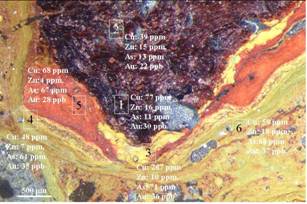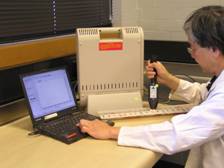research archivES
2005
- Ravi Anand, Matthias Cornelius and Balbir Singh (CEM Perth) have shown that certain parts of the range-land mulga vegetation can be used for basemetal and gold exploration in areas of transported regolith. (posted 21.4.05)
- At Lancefield gold deposit, Ravi Anand and Cajetan Phang (CEM Perth) have shown that nature and age of sediments impose a strong control on dispersion of elements in transported cover. They have identified three stages of dispersion of As, Cu, Zn, Pb and Au in sediments related to three weathering events at 60 Ma, 10 Ma and < Ma. (posted 21.4.05)
- Tom Cudahy (CEM Perth) and a team from LEME, Geological Survey WA, Placer Dome and HyVista Corporation have mapped the distribution of alteration and regolith minerals recorded in 26 HyVista flight lines on the Kalgoorlie -Kanowna 1:200 000 masheet. They produced maps of features like kaolinite abundance and cystallinity, iron oxide types and abundances, and mica compositions and abundances. (posted 21.4.05)
- Rob Hough (CEM Perth) and a team from LEME and ANU are studying regolith materials from the Mount Gibson Gold Deposit (300km NNE of Perth ). Alunite in transported regolith has elevated values of Cu, Pb, As and Au, indicating that alunite is a potential sampling medium to explore for buried mineralisation. (posted 21.4.05)

Figure: Example of micro mineral mapping by LA-ICPMS
- At Gossan Hill, Golden Grove, Ray Smith (CEM Perth) is demonstrating that diagnostic features like tuffaceous textures with cassiterite, micron-scale sulfide inclusions in quartz, Au inclusions and ferruginous pseudomorphs after sulfides, are all recognisable in clasts in lateritic cover 10m thick and at least 250m off strike from the massive sulphide system. (posted 21.4.05)
- Matthias Cornelius (CEM Perth) and team are well advanced in the production of geochemical map of the western Yilgarn Craton using lateritic residuum as the principal sample medium ("Yilgarn Laterite Atlas"). The project is demonstrating the feasibility and usefulness of producing such a map to enhance the prospectivity of the Yilgarn Craton, providing regional background for local exploration and baseline data for environmental studies. (posted 21.4.05)
- At Lake Lefroy , David Gray and Balbir Singh (CEM Perth) have demonstrated that using a portable hyperspectral analyser (ASD-Fieldspec Pro©) can distinguish rock types in saprolite and differentiate lake sediments from in situ regolith. (posted 21.4.05)

Portable ASD Spectroradiometer producing automatic mineralogical analysis from rapidly read VSWIR spectra.
PRE JULY 2005
REGOLITH GEOSCIENCE AND MINERAL EXPLORATION UNDER COVER
PROGRAM 1 AND 2
• Ravi Anand, Matthias Cornelius and Balbir Singh (CEM Perth) have shown that certain parts of the range-land mulga vegetation can be used for basemetal and gold exploration in areas of transported regolith.
• At Lancefield gold deposit, Ravi Anand and Cajetan Phang (CEM Perth) have shown that nature and age of sediments impose a strong control on dispersion of elements in transported cover. They have identified three stages of dispersion of As, Cu, Zn, Pb and Au in sediments related to three weathering events at 60 Ma, 10 Ma and < Ma.
• Tom Cudahy (CEM Perth) and a team from LEME, Geological Survey WA, Placer Dome and HyVista Corporation have mapped the distribution of alteration and regolith minerals recorded in 26 HyVista flight lines on the Kalgoorlie -Kanowna 1:200 000 masheet. They produced maps of features like kaolinite abundance and cystallinity, iron oxide types and abundances, and mica compositions and abundances.
• Rob Hough (CEM Perth) and a team from LEME and ANU are studying regolith materials from the Mount Gibson Gold Deposit (300km NNE of Perth ). Alunite in transported regolith has elevated values of Cu, Pb, As and Au, indicating that alunite is a potential sampling medium to explore for buried mineralisation.
• At Gossan Hill, Golden Grove, Ray Smith (CEM Perth) is demonstrating that diagnostic features like tuffaceous textures with cassiterite, micron-scale sulfide inclusions in quartz, Au inclusions and ferruginous pseudomorphs after sulfides, are all recognisable in clasts in lateritic cover 10m thick and at least 250m off strike from the massive sulphide system.
• Matthias Cornelius (CEM Perth) and team are well advanced in the production of geochemical map of the western Yilgarn Craton using lateritic residuum as the principal sample medium ("Yilgarn Laterite Atlas"). The project is demonstrating the feasibility and usefulness of producing such a map to enhance the prospectivity of the Yilgarn Craton, providing regional background for local exploration and baseline data for environmental studies.
• At Lake Lefroy , David Gray and Balbir Singh (CEM Perth) have demonstrated that using a portable hyperspectral analyser (ASD-Fieldspec Pro©) can distinguish rock types in saprolite and differentiate lake sediments from in situ regolith.
ENVIRONMENTAL APPLICATIONS OF REGOLITH GEOSCIENCE, SALINITY MAPPING AND HAZARD ASSESSMENT
PROGRAMS 3 AND 4
• In the West Australian Wheatbelt Steve Rogers and Rob Fitzpatrick (LW Adelaide ), David G ray, and Mark Pirlo (CEM Perth) are studying the trace element geochemistry of acid saline waters in salinity mitigation drains. They have shown that trace elements and rare earth minerals are present in highly elevated concentrations exceeding Australian water quality guidelines. The outcomes of this work will have a major impact on drain design and management of drain water receiving environments
• At the Loveday Basin wetland adjacent to the River Murray, Sebastien Lamontangne, Steve Rogers, and Rob Fitzpatrick (LW Adelaide) and Warren Hicks (LW Canberra) are studying the mineral and trace element geochemistry of sulfidic sediments, that have the potential to oxidise and produce sulfuric acid. The work is assisting land managers and state NRM agencies in developing appropriate remediation options for River Murray wetland systems.
• Jim Cox, Michael Durkey, Chris Smit and Phil Davies (CLW Adelaide) have assessed the effects of a shallow groundwater drain through the Bald Hill Flats (part of the Upper SE, South Australia drainage program) and suggest it will be very effective at lowering the water-tables, provided certain regolith constraints are met.
• Richard Cresswell (CLW Brisbane) has found that vertical mobility of salts is more important in defining salinity outbreaks in the Hodgson Creek Catchment (Queensland MDB) than is lateral groundwater movement.
• John Dighton (CLW, Adelaide ) has developed a novel, yet simple method for routine d 34 S measurements on water and high-sulphur minerals.
• Richard Cresswell (CLW Brisbane) and Andrew Herczeg (CLW Adelaide) have combined airborne geophysics, hydrogeochemistry and hydrogeology to define recharge and aquifer parameters across 3 NAPSWQ focus catchments ( Upper Broughton [figure below] , Angas-Bremer, SA and Lower Balonne , Queensland ) and explain how and where salinity is expressed.
• Jim Cox, Chris Smitt, Andrew Herczeg, Glen Walker and Phil Davies (CLW Adelaide) joined with John Wilford (CRC LEME/GA) to realise that rainfall is the primary factor governing salt stores in the Bremer Hills, SA, while depth of weathering governs the actual amount of salt mobilised.
• Richard Cresswell (CLW Brisbane) has generated revised salt accession maps for Australia and is co-ordinating (with Andrew Herczeg and John Dighton (CLW Adelaide) the establishment of a network of rainfall collectors across the country to generate a baseline for ion accession isotope variability.
|
